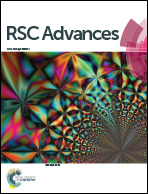Biomimetic design: a programmed tetradecapeptide folds and auto-dimerizes as a stereochemically articulated receptor protein†
Abstract
In order to mimic biogeny, protein-quaternary structure may be evolved to the desired structure specificity—as a fold, assembly, and sequence—in a hierarchy of independent design steps. In demonstration of the algorithm, octapeptides were accomplished to obtain the desired structural specificity as folds, assemblies, and sequences over a hierarchy of design steps; the approach was shown to extend the structure by allowing amino acid stereochemistry to be applied as a design variable. Moreover, it was proven to simplify design by allowing the programming to involve a hierarchy of independent steps. Illustrating the abovementioned approach of biomimetic design with involvement of amino acid stereochemistry as the design variable, we now report an example of functional design, in which a fourteen-residue sequence was accomplished to the desired binding specificity as a receptor protein, first in the fold stereochemically, then in the assembly spatially, and finally in the sequence chemically.


 Please wait while we load your content...
Please wait while we load your content...